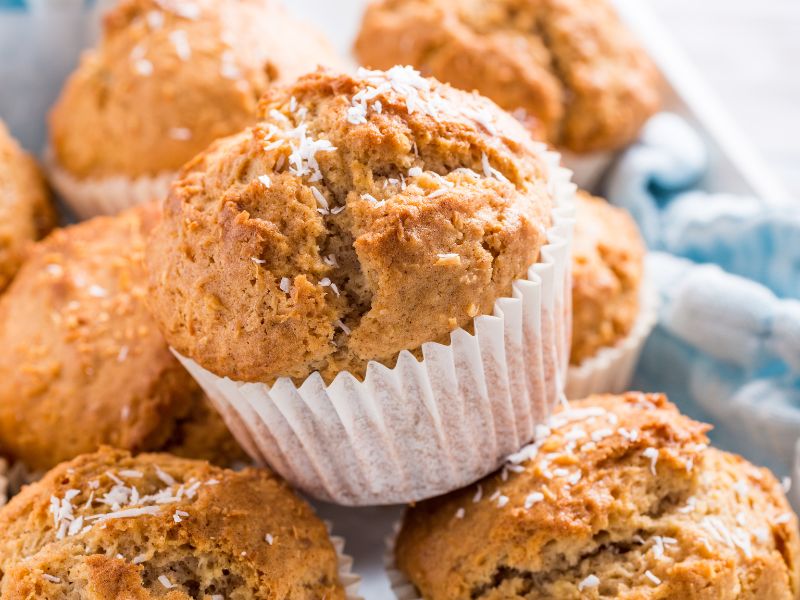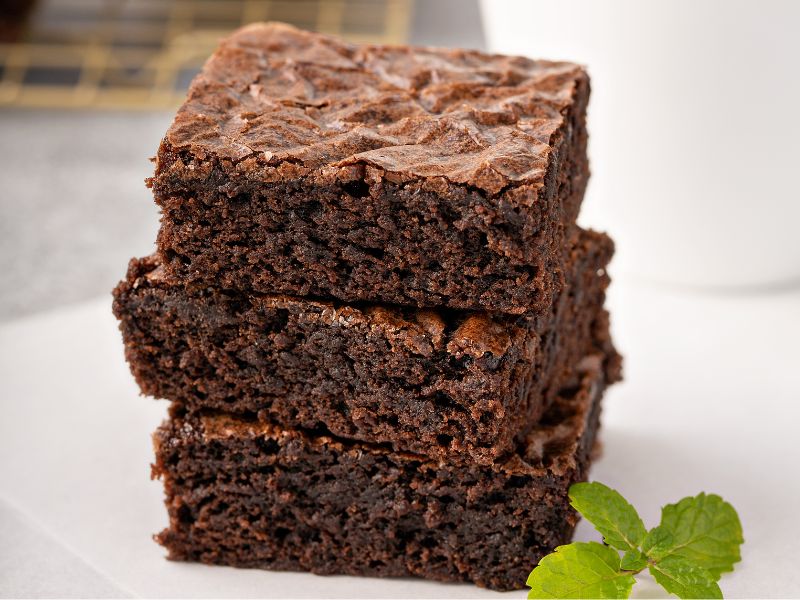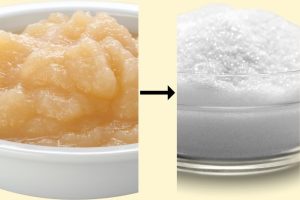In the world of baking, certain questions spark curiosity and debate. “Can I substitute applesauce for sugar?” is one of them. As we become more health-conscious and look for natural alternatives, the interest in using applesauce as a sugar substitute has grown. But is it a straightforward swap? And what does this mean for the taste and texture of our baked goods? Let’s explore the ins and outs of this baking substitution, and shed light on its benefits, challenges, and the best ways to introduce it into your recipes.
The Science Behind Sugar in Baking

Sugar isn’t just about sweetness. It plays several important roles in baking that go beyond taste.
The Role of Sugar
- Sweetness: The primary reason we add sugar to our recipes. It enhances the flavor of other ingredients.
- Browning and Caramelization: Sugar reacts with proteins in a process called the Maillard reaction, leading to that lovely golden-brown hue in baked goods.
- Texture and Moistness: Sugar helps in creating a tender crumb in cakes and chewiness in cookies.
For an in-depth explanation of sugar’s role in baking, read this.
The Role of Applesauce
Applesauce is more than just a sweet, fruity puree. When introduced to baking, it brings its own set of properties that can significantly influence the outcome of your baked goods.
- Natural Sweetness: Applesauce gets its sweetness primarily from fructose, a natural sugar found in fruits. This type of sweetness is milder and more subtle than the intense sweetness of granulated sugar. It can lend a gentle, fruity note to baked goods, making them taste naturally sweet without being overpoweringly sugary.
- Moisture: One of the standout features of applesauce is its ability to add moisture to baked goods. This is particularly beneficial for recipes that tend to dry out, such as certain types of cakes or bread. When you replace sugar with applesauce, you’re introducing additional water content, which can result in a softer, moister crumb. This is why applesauce is often a favorite in recipes for muffins, brownies, and other moist desserts.
- Pectin: Apples contain pectin, a natural thickener. When apples are cooked down into applesauce, some of this pectin remains, giving the sauce a slightly gelatinous texture. In baking, this pectin can influence the structure and texture of the finished product. For instance, it can provide a certain level of binding in recipes, which can be particularly useful in vegan baking where eggs are not used.
- Acidity: Applesauce has a mild acidic nature, which can interact with leavening agents like baking soda. This interaction can influence the rise and texture of baked goods. It’s essential to be mindful of this, especially if the original recipe doesn’t account for the added acidity.
- Fat Reduction: Applesauce is often used as a substitute for fats like oil or butter in baking. Its creamy consistency can mimic the moisture provided by fats, allowing for a reduction in the overall fat content of the recipe. This is especially beneficial for those looking to make lighter, healthier versions of traditional baked goods.
- Flavor Profile: Beyond its sweetness, applesauce can introduce a subtle apple flavor to recipes. This can be a delightful addition to many baked goods, adding a layer of complexity and depth. However, for those recipes where an apple flavor might not be desired, it’s a good idea to use unsweetened and unflavored applesauce.
Adding applesauce to your baking can open up a world of possibilities. However, like any ingredient, understanding its properties and how it interacts with other ingredients is key to getting the best results.
Benefits of Using Applesauce as a Sugar Substitute
| 🍎 Benefits of Using Applesauce as a Sugar Substitute 🍎 | |
|---|---|
| Reduced Caloric Intake | Applesauce has fewer calories compared to sugar, making it a waistline-friendly option. |
| Nutritional Boost | Applesauce provides essential vitamins and dietary fiber, unlike refined sugar. |
| Lower Glycemic Index | Natural sugars in applesauce cause a slower rise in blood sugar levels. |
| No Artificial Additives | Applesauce is a natural product without artificial ingredients found in many sugar substitutes. |
| 🍪 Brought to You by wearebaking.com 🍪 | |
Choosing to replace sugar with applesauce in your baking recipes isn’t just about cutting down on sweetness. This substitution offers many benefits, both from a health perspective and in terms of baking outcomes.
Health Benefits
- Reduced Caloric Intake: One of the primary reasons many bakers choose applesauce, is its lower calorie content compared to sugar. By making this switch, you can enjoy your favorite baked goods with fewer calories, making it a more waistline-friendly option.
- Nutritional Boost: Unlike refined sugar, which primarily offers empty calories, applesauce brings along a range of nutrients. It’s a source of essential vitamins, such as vitamin C and some B vitamins. Additionally, applesauce provides dietary fiber, which aids in digestion and promotes a feeling of fullness.
- Lower Glycemic Index: The natural sugars in applesauce have a lower glycemic index compared to refined sugars. This means they cause a slower, more gradual rise in blood sugar levels, which can be beneficial for those monitoring their blood sugar or looking for sustained energy.
- No Artificial Additives: Many commercial sugar substitutes contain artificial ingredients and sweeteners. In contrast, applesauce is a natural product, especially if you opt for organic or homemade versions without added preservatives.
Baking Benefits
- Enhanced Moisture: Applesauce is by nature moist, and when used in baking, it can add this moisture to the finished product. This is particularly beneficial for recipes that can be prone to drying out, ensuring a tender and moist crumb in cakes, muffins, and more.
- Versatility: Applesauce can be used in a wide range of baked goods, from cookies and cakes to bread and pastries. Its mild flavor profile ensures it doesn’t overpower other ingredients, making it a versatile sugar substitute.
- Texture Improvements: The pectin in applesauce can influence the texture of baked goods, often resulting in a softer, more cohesive crumb. This can be especially useful in gluten-free baking, where achieving the right texture can be challenging.
- Natural Sweetness: While applesauce does bring sweetness, it’s a more natural and subtle kind. This can elevate baked goods, giving them a more sophisticated flavor profile without the intense sweetness that refined sugar can sometimes bring.
- Cost-Effective: Making homemade applesauce can be a cost-effective way to have a sugar substitute on hand. Especially during apple season, you can make your own applesauce for future use, seeing to it that you always have a natural sweetener ready for your baking endeavors. Watch the video below.
Using applesauce as a sugar substitute in your baking can be an altering experience. Not only does it offer health benefits, but it can also elevate the taste and texture of your baked goods, making them more wholesome and flavorful.
Just want to make a small batch of homemade applesauce. Try this recipe
How To Substitute Applesauce For Sugar?

Substituting applesauce for sugar isn’t as simple as a one-to-one swap. There are several factors to consider to ensure your baked goods turn out just as delicious, if not more so. Here’s a detailed guide on how to make this substitution effectively:
Conversion Ratios
- General Guideline: A common starting point is to use 3/4 cup of applesauce for every cup of sugar. This ratio ensures you’re getting a similar level of sweetness without making the batter or dough too wet.
- Recipe Specifics: However, the ideal ratio can vary based on the specific recipe. For instance, denser baked goods like brownies might require a different ratio compared to lighter cakes or muffins. It’s always a good idea to start with a tested recipe that already uses applesauce as a sugar substitute before making your own adjustments.
Adjusting Liquid Content
- Compensating for Moisture: Applesauce introduces additional moisture to recipes. To account for this, you’ll often need to reduce other liquids in your recipe. A general rule is to decrease the liquid (like milk, water, or oil) by about 1/4 cup for every cup of applesauce you add.
- Balancing Dry Ingredients: In some cases, you might also need to slightly increase the amount of dry ingredients to ensure the batter or dough isn’t too wet. This could mean adding a bit more flour or other dry components.
Baking Time Adjustments
- Monitoring Closely: Due to the added moisture from applesauce, baked goods might require a longer baking time. It’s crucial to keep a close eye on them, especially if you’re trying the substitution for the first time.
- Testing for Doneness: Always use the toothpick or knife test to check if your baked goods are done. Insert it into the center; if it comes out clean or with a few crumbs, it’s ready. If it’s wet, give it a few more minutes.
Considering Acidity
- Interactions with Leavening Agents: Applesauce is mildly acidic, which can react with baking soda, a base. This reaction can produce carbon dioxide, affecting the rise of your baked goods. If your recipe originally calls for baking powder, you might need to adjust the amount or consider using a combination of both baking powder and baking soda.
Flavor and Sweetness Adjustments
- Taste Test: Since applesauce is less sweet than sugar, you might want to do a taste test of your batter or dough. If it’s not sweet enough, consider adding a natural sweetener like honey or maple syrup to boost the sweetness without resorting to sugar.
- Flavor Profile: Remember, applesauce can introduce a mild apple flavor to your baked goods. While this can be delightful in many recipes, if you’re aiming for a neutral flavor, go for unsweetened and unflavored applesauce.
Substituting applesauce for sugar can be a rewarding experience, allowing you to enjoy healthier versions of your favorite treats. However, it’s important to approach the process with knowledge and patience, making adjustments as needed to achieve the best results.
Challenges and Solutions When You Substitute Applesauce For Sugar

While applesauce offers numerous benefits as a sugar substitute, it’s not without its challenges. Understanding these challenges and knowing how to tackle them can make your baking endeavors more successful.
Texture Differences
- Challenge: One of the most common issues bakers face when using applesauce in place of sugar is a change in texture. Baked goods might turn out denser or spongier than expected.
- Solution: To counteract this, consider combining applesauce with other sugar substitutes, such as honey or agave nectar. Additionally, tweaking the amount of baking powder or baking soda can help achieve the desired texture. For instance, adding a bit more baking powder can introduce more airiness to the batter, leading to a lighter crumb.
Flavor Considerations
- Challenge: Applesauce, especially if it’s flavored or sweetened, can introduce a distinct apple note to your baked goods. While this can be delightful in some recipes, it might not be desired in others.
- Solution: Go for unsweetened and unflavored applesauce to maintain a neutral flavor profile. If the apple flavor is too strong, consider blending applesauce with another neutral-tasting sugar substitute, like mashed bananas or yogurt.
Browning and Caramelization
- Challenge: Sugar plays a crucial role in the browning and caramelization of baked goods. Since applesauce doesn’t caramelize like sugar, you might find your treats lacking that signature golden-brown finish.
- Solution: One approach is to use a blend of sugar and applesauce. This way, you still reduce the overall sugar content while retaining some of the browning properties. Alternatively, you can adjust your oven’s temperature. Baking at a slightly higher temperature for a shorter duration can promote better browning.
Shelf Life and Storage
- Challenge: Baked goods made with applesauce can have a shorter shelf life due to the added moisture content. They might also be prone to mold if stored in a humid environment.
- Solution: Consider storing these baked goods in the refrigerator to extend their freshness. If you’re baking something meant for longer storage, like cookies, consider reducing the applesauce content or combining it with other preservatives like lemon juice.
Sugar’s Role in Preservation
- Challenge: Sugar acts as a preservative, extending the shelf life of many baked goods. When you reduce or eliminate sugar by using applesauce, you might find that your treats don’t last as long.
- Solution: For items meant for longer storage, consider using a combination of applesauce and sugar. Alternatively, you can explore natural preservatives or store the baked goods in airtight containers to maintain freshness.
Substituting applesauce for sugar is an art as much as it is a science. While it introduces a set of challenges, with the right knowledge and a bit of experimentation, you can achieve delicious results that are both healthier and satisfying.
Baked Goods to Try with Applesauce



Applesauce, with its natural sweetness and moisture, can be a fantastic addition to various baked goods. While almost any recipe can be tweaked to incorporate applesauce, some baked items especially shine when this fruity puree is added. Here’s a closer look:
Muffins and Quick Breads
- Why They Benefit: These baked goods often rely on moisture to achieve a soft, tender crumb. Applesauce not only provides this moisture but also adds a subtle fruitiness that can elevate the overall flavor.
- Tips: When substituting sugar with applesauce in muffins or quick breads, consider reducing the other liquid ingredients slightly to maintain the right batter consistency.
Pancakes and Waffles
- Why They Benefit: Applesauce can make your breakfast favorites fluffier and moister. Plus, the natural sweetness means you might need less syrup or toppings.
- Tips: If your batter becomes too thick due to the applesauce, a splash of milk or water can help achieve the desired consistency.
Brownies and Bars
- Why They Benefit: Who doesn’t love a fudgy brownie? Applesauce can enhance the chewiness and moisture content of brownies and bars, making them irresistibly soft.
- Tips: Since applesauce adds moisture, you might need to extend the baking time slightly. Keep an eye on your brownies and do the toothpick test to ensure they’re baked to perfection.
Cakes
- Why They Benefit: Whether it’s a simple sponge cake or a decadent chocolate one, applesauce can provide added moisture, ensuring your cakes aren’t dry. It’s especially beneficial for recipes that are naturally drier or when using whole grain flours.
- Tips: If you’re making a layered cake, ensure the consistency is sturdy enough to hold up. You might need to adjust the ratio of dry to wet ingredients.
Oatmeal Cookies
- Why They Benefit: Oatmeal cookies can sometimes turn out too dry or hard. Applesauce introduces moisture and a natural sweetness that complements the earthy flavor of oats perfectly.
- Tips: Since applesauce adds moisture, your cookies might spread less. If you prefer thinner cookies, consider flattening them slightly before baking.
Pie Fillings
- Why They Benefit: While not a direct substitute for sugar in pie fillings, applesauce can be combined with the primary fruit to add sweetness, reducing the need for added sugars. It’s especially great in apple pies or mixed fruit pies.
- Tips: Be mindful of the moisture content. If your pie filling seems too wet, consider adding a thickening agent like cornstarch or tapioca.
Adding applesauce to your baking can lead to delightful results, both in terms of flavor and texture. While it’s a versatile ingredient, starting with these recommended baked goods can give you a solid foundation for further experimentation.
Final Thoughts
The world of baking is as vast as it is delicious, and the ingredients we choose play a vital role in the final taste, texture, and nutritional value of our baked goods. The decision to replace sugar with applesauce is more than just a trend; it’s proof to the advancing nature of baking and our ongoing quest for healthier, yet equally delicious alternatives.
Applesauce, with its natural sweetness and moisture-rich profile, offers bakers a unique opportunity to reinvent classic recipes. From the soft crumb of muffins to the chewy delight of brownies, the inclusion of applesauce can transform the very essence of a dish, often for the better. But like all ingredients, it comes with its set of challenges. Understanding its properties, knowing when and how to use it, and being open to a bit of trial and error can make all the difference.
The benefits of using applesauce go beyond health. It’s about introducing new textures, flavors, and experiences to our taste buds. It’s about making baking more in-depth, catering to those who might be watching their sugar intake or looking for natural alternatives.
So, the next time you’re whipping up a batch of your favorite treats, consider reaching for that jar of applesauce. Whether you’re a seasoned baker or someone just starting out, the journey of experimenting with applesauce promises delightful surprises and, more importantly, scrumptious outcomes.
Remember, baking is as much about the process as it is about the end product. Embrace the adventure, savor the flavors, and, most importantly, enjoy every bite!
Have you tried to substitute applesauce for sugar? Please leave me a comment below.
And As Always
Keep On Baking!
Taianne

I’m Taianne, the owner and operator behind We Are Baking. Baking my first cake at age 11 hooked me on creating sweet treats. Though my interest faded during childhood, it was rekindled when I married my apple pie-loving husband. I love trying new recipes, tweaking classics, and helping others learn the science and art of baking. I started We Are Baking to share tips, tricks, and favorite recipes I’ve discovered over the years. When not in the kitchen, I enjoy spending time with family and friends. My goal is to inspire others to embrace their creativity through baking. Feel free to contact me with any questions!
Taianne@wearebaking.com

